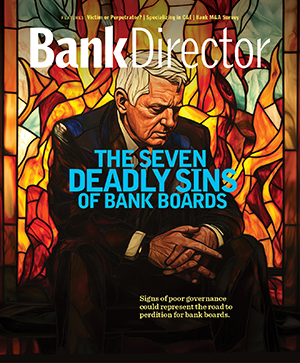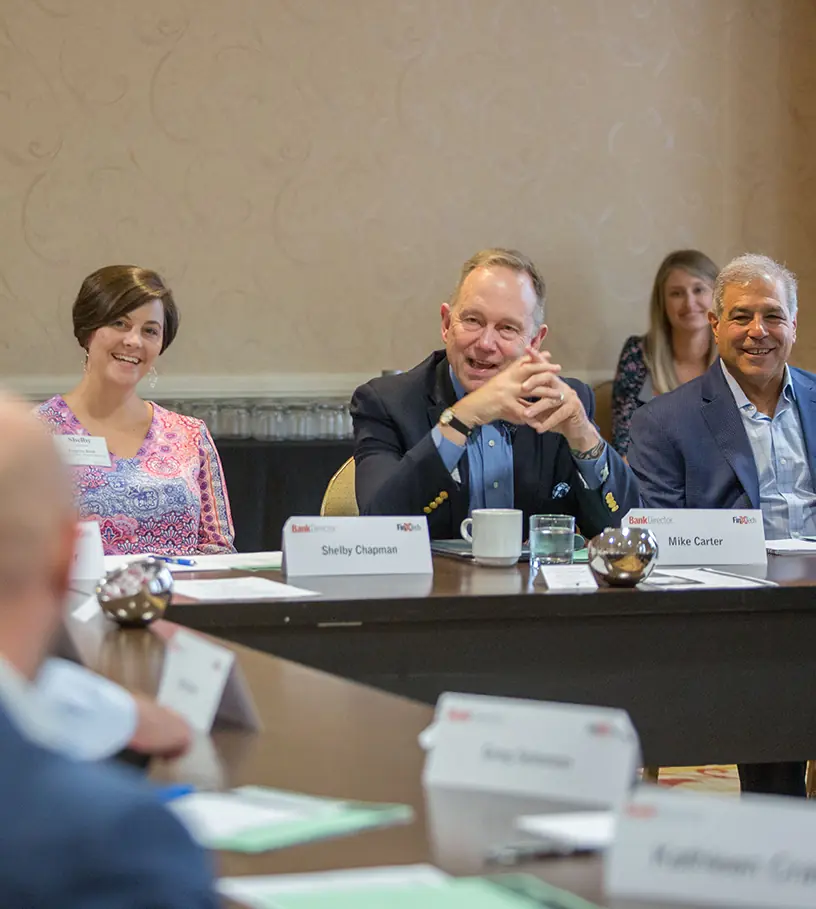
Bridging the Talent Gap
For years, reports have circulated about the emerging talent crisis in corporate America. Thus, for many, this may seem like old news. Yet recent changes in demographics among C-suite executives and board members have resulted in an immediate need for well-qualified, next-generation talent to ensure ongoing performance and business vitality.
So while the talent deficit has been recognized for some time, industry experts have noted a remarkable change this past year, characterized by both ownership and action. Namely, CEOs as well as boards of directors are taking ownership of this challenge and are prodding their companies into action.
Business objectives fuel change
What has happened to change the mindset? First, many boards now realize that talent management is a business issue, and one that is not going away. The pool of skills necessary to drive bank revenue and growth have practically dried up in highly competitive markets such as Jacksonville, Florida, where many banks have found market expansion constrained by insufficient talent to staff new branches. Furthermore, the impending scarcity is beginning to affect near-term business planning. For example, a growing body of research (Gartner, among others) identifies the critical shortage of IT workers; considering this the top barrier to growth in the IT channel, Cisco Systems launched innovative talent initiatives to accelerate channel partner growth.
However, the most significant change overtaking the mindset of the business world related to talent management is that this area is no longer considered an agenda pushed solely by HR. Today this need is being driven by strategic business objectives, and as such, business leaders themselves are demanding more development of future talent.
Part of the reason business leaders are taking a proactive approach is because they see tangible evidence of impending vacancies right in front of them. C-suite turnover has increased, according to business press reports over the last two years. In 2007, for example, more than 16% of Fortune 500 CEOs left their positions, a three-year high, noted a March 2008 Inc.com report; similarly, 25% ofFortune 1000 CFOs jumped ship, according to a Memphis Business Journal article citing a March 2008 CFO magazine report.
Thus, competition to stock the ranks with experienced financial talent is becoming much tougher. What were once seen as abstract statistical trends have now evolved into empty offices. Whatu00e2u20acu2122s more, bank CEOs are facing as much as 50% of their experienced team becoming eligible for retirement in the next four to eight years. In the United States, the number of workers in the 55-and-older group is projected to grow by 47% in the next eight years, according to an April report on Management-Issues.com, an independent, online business journal.
Not only is talent shortage a constraint on business growth, in todayu00e2u20acu2122s world, it also represents an unacceptable business risk. Samuel P. Golden, managing director and national practice leader for Alvarez and Marsalu00e2u20acu2122s Financial Institutions Advisory Services practice and recently retired OCC ombudsman, believes strongly that a review of talent retention and planning should be included in the field examinations of all banks to gauge the exposure associated with potential gaps in succession. Basing his assessment on his 34 years of experience with the OCC, Golden says this is a key concept that banks and boards should not underestimate.
u00e2u20acu0153It is what you do to attract, select, develop, motivate, reward, and retain talented people that will not only build a strong organizational culture but will also separate those banks that will ultimately be successful from those that will not,u00e2u20ac Golden states.
Ready or not u00e2u20acu00a6 6 steps toward a stronger program
Those banks struggling to deal with the challenge of executive talent management should know they are not alone. It is a pervasive situation in the industry today. The good news is, there are some steps that can be taken to address these issues before the gap widens.
The following points offer some concise lessons from industry experts as well as from companies that have instituted leading talent management practices in various industries.
1. First and foremost, start now. The talent gap will only continue to grow wider, and the longer you wait, the deeper the hole becomes. So first, get talent management on the table for discussionu00e2u20ac”immediately.
2. Own it. One of the toughest parts of the message is that the CEO and the entire leadership team must accept that they own this issue. This is not an HR problem; it is a business problem. The role of HR is to provide expertise and applicable tools to help management solve the problem. Many CEOs have doomed their own talent management program by tossing it over to HR to fix. The CEO and board must be ready to change leadership behavior: commitment, ownership, and accountability by all business managers will be a prerequisite going forward.
3. Begin with the basic building blocks. There are some fundamental elements to talent management that require more action than genius and thus can be put in place today. These include identifying critical roles in the company, talking about succession plans, thinking about career paths, identifying your high potentials, having truthful discussions about performance, and identifying development gaps. If your company is not already practicing these basic components, begin with small, easy initiatives, then perfect and enhance them over time.
4. Know the ultimate end game. What successful, talent-driven companies can teach us is that all the separate building blocks that make up a successful talent development program (attracting, hiring, measuring performance, developing, rewarding, retaining) need to be connected and integrated in such a way that they reinforce each other and link directly to the needs of the business. This is a total systems solution, not a quick fix; stand-alone pieces donu00e2u20acu2122t have the necessary impact and ultimately can cause the program to fail. Thus, banks should build their talent development program with the complete organizational structure in mind: Even if you need to construct the steps one by one, it is important to know how they will fit together in the end. Successful organizations begin with the alignment of the leadership team around a shared-talent philosophy.
5. Train your business managers to be talent managers. The Achillesu00e2u20acu2122 heel of many talent efforts is failure to recognize the changes that are required. Donu00e2u20acu2122t overlook the need to train even seasoned executives in the art and science of talent management. And afterward, hold them accountable as leaders in the talent management process. Along with their many other areas of expertise, talent management must become their jobu00e2u20ac”some might even argue it should be their No. 1 job.
6. Over time, move from reactive to proactive. If one clear indication of progress is the extent to which the pieces are integrated, the second will be the extent to which you have the capacity to anticipate future talent need. Successfully competing for scarce talent will require you to move away from a reactive mode of filling the succession gap of the day and toward a proactive mode of building pools of talent to draw from. This will require knowledge and data, both internal and external.
One banku00e2u20acu2122s story
To see how all of these points can be implemented in a real world situation, consider Webster Bank, N.A., a $17.2 billion institution headquartered in Waterbury, Connecticut. During the past two years of OCC examinations reviewing Websteru00e2u20acu2122s human resources area in conjunction with other segments of the bank that were subject to review, the OCC examiners indicated a u00e2u20acu0153best in classu00e2u20ac designation for Websteru00e2u20acu2122s comprehensive talent management initiative, indicating they had not seen as thorough and as comprehensive of a program, even compared to the larger banks that came under their purview.
Webster Bank began conceptually with a performance management program as its foundation. Like many other companies, prior to this point, performance management at Webster lacked employee and management commitment because it was treated as a stand-alone process, disconnected from other elements of the business cycle. Websteru00e2u20acu2122s performance objectives did not link to its business strategy, and the program did not provide a means to assess important cultural and values-based behaviors that the bank sought in its employees. Even when performance gaps were identified, the process did not include the creation of development plans, leading to little improvement.
Implementing such a far-reaching program takes prescient leadership. Websteru00e2u20acu2122s chairman and chief executive officer, James C. Smith, recognized that performance management was pivotal to the longer-term objective of establishing a comprehensive talent management program, and thus made it a key priority. Under the guidance of an executive group, including Smith and his direct reports, a cross-functional team staffed by individuals with strong organizational credibility redesigned the performance management process and worked hard to gain management support.
The importance of having a well-thought-out performance management process was the No. 1 issue that had surfaced from the results of a recent employee survey. The employees had expressed the need to have a performance process that provided clear linkage to the overall corporate strategy. Therefore, employee focus groups were established to gain insight into areas that needed change to the performance management process before, during, and after the new initiative. The cross-functional team provided check-ins to the senior leadership team to assure engagement and buy-in to the overall approach.
All employees participated in training, which was broken into three phases: performance planning or setting objectives; performance/coaching check-in, which included the establishment of a development plan plus reviewing how progress was being made against goals on a mid-year basis; and finally, performance feedback, covering how well an employee did against the agreed-upon goals established during the earlier goal-setting process. This comprehensive training and communication program provided managers and employees with a clarity of understanding regarding the new performance process, which helped establish support throughout the bank. Numerous articles and communication via the banku00e2u20acu2122s newsletter and on its intranet also helped heighten awareness and understanding.
Over many months, the bank analyzed and measured employeesu00e2u20acu2122 goal-setting and goal-attainment abilities, including how employees went about accomplishing goals from a competency and behavioral standpoint, which allowed Webster to pinpoint developmental opportunities. In essence, this enabled the bank to create a talent forum in which succession plans were shared and development opportunities in the form of new assignments were discussed both functionally and cross-functionally with candidates who had been identified for current and future openings. These results were also shared with the banku00e2u20acu2122s compensation committee and the full board. After a year of gathering this information gained through the banku00e2u20acu2122s fully implemented performance management process, the company had a clearer picture of both individual performance and the competencies through which key business results were accomplished. This data provided critical input for the design of a more comprehensive talent management process.
In the next stage, Websteru00e2u20acu2122s human resources department, along with the support and involvement of senior management, created a talent forum where business and operating heads publically showcased the performance and talent of their key employees to senior leadership. The heightened visibility of a certain individualu00e2u20acu2122s performance clearly signaled that operating supervisors were accountable for identifying and developing talent for the banku00e2u20ac”and that senior management viewed this as an important aspect of their jobs.
In addition, performance reviews were broadened and made more substantive. Development plans were now articulated, feedback was provided, and suggestions were made for rotational assignments, including assignments in other functional areas that required buy-in and support across the organization.
All of these developments led to the completion of robust succession plans (starting with the top three management levels), with candidates identified as u00e2u20acu0153ready nowu00e2u20ac or u00e2u20acu0153ready in 1u00e2u20ac”2 years.u00e2u20ac Ultimately, the human resources team shared talent review and succession plans with the board of directors and its compensation committee, which offered their high-level support to the program.
Finally, the topic of compensation was integrated into the overall talent management system: Individuals identified as u00e2u20acu0153top talentu00e2u20ac were given consideration to receive significant restricted stock grants.Thus, both the stock grants and the recognition of individuals at the board level served to increase retention of Websteru00e2u20acu2122s valued employees.
The result at Webster Bank was a comprehensive talent management system supported by business managers in which all the HR programs reinforced each other and integrated with the business strategy, creating a process that was highly visible throughout the organization.
The broader view
Bank leaders must think about managing their people resources just as carefully as they do their financial resources or their operational business plan. It is leadershipu00e2u20acu2122s responsibility to clearly communicate its intentions and strategy for talent. A formal program that features the aspects discussed above need not be overly complicated, but it does require having a systematic way to fully integrate talent planning with strategic and financial planning and talent management with business management.
These building blocks can be put in place today. But the real key to sustainable success is to take a sufficiently broad approach to talent. This process is not just about filling open positions, or getting and keeping people. The larger business challenge is to build a competitive advantage through the development of the organizationu00e2u20acu2122s capabilities. HR provides business leaders with the processes and talent expertise that enable them to fulfill their business intentions around talent. But a successful talent management program only truly succeeds when business leaders own the ideau00e2u20ac”and have accountability for managing talent.

Join OUr Community
Bank Director’s annual Bank Services Membership Program combines Bank Director’s extensive online library of director training materials, conferences, our quarterly publication, and access to FinXTech Connect.
Become a Member
Our commitment to those leaders who believe a strong board makes a strong bank never wavers.

